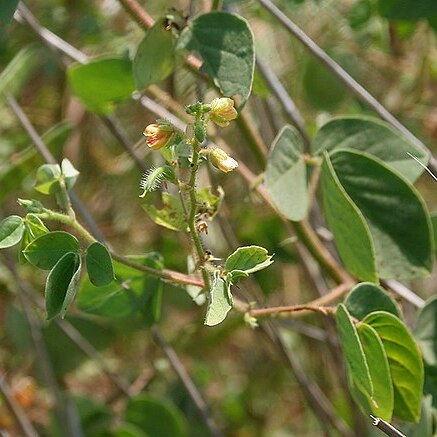Annual erect sticky herb, sometimes woody at the base. Stems terete, lightly ridged, hirsute with hispid and glandular hairs of various lengths. Leaves paripinnate; rachis 3-5.5 cm long; stipules 3-6 x 0.5-1 mm, narrowly triangular, hirsute with glandular hairs; petiolar glands absent; leaflets in 2 pairs, 1.7-4.7 x 1.2-3.2 cm, broadly elliptic to broadly obovate, cuneate on proximal side, rounded on distal, apex rounded to obtuse or broadly acute, mucronulate, base asymmetric, sparsely appressed-pubescent on both surfaces; midrib median; 0-1 lateral nerves from base on proximal side, 1-2 on distal side. Inflorescences terminal, racemose, becoming leaf-opposed through growth of an axillary bud; bracts c. 2.5 x 1.5 mm, ovate, base cordate, apex acuminate; pedicels 0.3-1 cm long, with 1-2 minute bracteoles. Sepals 4.1-6.3 x 1.7-3 mm, glandular-hairy outside. Petals yellow, buff or orange, usually with darker markings, 6.5-8.7 x 3-4 mm, including the 1.5 mm long claw, broadly obovate. Stamens 5-6, subequal. Ovary 4 mm long, densely appressed-hairy; style c. 2 mm long, glabrous; stigma subterminal, oblique. Pods 4-5 x 0.6-0.8 cm, oblong, sparsely glandular-hairy. Seeds black, shiny with scattered surface pitting and brown dots, 5-6.5 x 3.5-5 mm, rhomboid to elliptic in outline, flattened.
Herb or small shrub up to 60(-100) cm, sticky through viscid bristles. Leaves with 2 (or 1) pair(s) of leaflets; stipules linear, acute, 2-4 mm; petiole viscid-bristly, 2.5-3.5 cm; rachis 5-8 mm with a tiny, 0.5 mm long, ligulate-acute gland between each pair of leaflets. Leaflets subsessile, membranous, very unequal-sided, ovate-lanceolate, 2-3 by 1-2 cm, apex rounded or acute, base rounded or cuneate; puberulous or pubescent on both surfaces. Racemes terminal or axillary, 4-12 cm long, lax-flowered, shortly pedunculate; bracts ovate-auriculate, 2 mm; bracteoles very small; pedicels 3-4 mm, velutinous. Sepals narrowly ovate, 3-4 mm, with glandular hairs outside. Petals yellow turning brick-red, obovate, subequal, 5-7 mm, claw short. Stamens 5, subequal; filaments c. 2 mm; anthers 1-2 mm, with lateral rims opening at apex and gradually downwards to the base; staminodes absent. Ovary densely strigose; style glabrous; stigma spathulate, recurved, ciliate. Pods flat, on a 5 mm long stalk; strap-shaped, 4-5 by 0.7-0.8 cm. Seeds 5-8, ovate, flattish, 3-4 mm.
An evergreen shrub. It grows 5 m high and spreads 3 m wide. The stem is slender and erect. The branches are spreading. The leaves are alternate and have 4 triangle shaped leaflets. They are 2.5 cm long. The flowers are yellow. They are in clusters at the ends of branches. The fruit are long, flat, pointed pods.
Semi-erect herb, up to 0.6 m high, glandular, viscid. Leaves with 2 pairs of leaflets only. Flowers 5-6 mm long. Pods oblong-linear, 30-555 x 5-8 mm, valves setose to pilose with scattered, rather stiff, glandular-based hairs. Flowers yellow.


